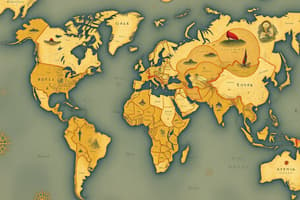Podcast
Questions and Answers
What is the focus of Human Geography?
What is the focus of Human Geography?
- Climate zones and weather patterns
- Geospatial technologies and data analysis
- Natural landforms and ecosystems
- Human activities and their interactions with the environment (correct)
Which of the following best describes a 'region' in geographic terms?
Which of the following best describes a 'region' in geographic terms?
- A specific set of coordinates
- A place characterized solely by climate
- An area defined by common features (correct)
- A location that is a transportation hub
Which theory explains agricultural land use based on distance from a market?
Which theory explains agricultural land use based on distance from a market?
- Von Thünen Model (correct)
- Colonial Dependency Theory
- Ratzel’s Organic Theory
- Central Place Theory
Which of the following is a major area of study within Environmental Geography?
Which of the following is a major area of study within Environmental Geography?
What is a topographic map primarily used for?
What is a topographic map primarily used for?
Which option relates to the concept of 'movement' in geography?
Which option relates to the concept of 'movement' in geography?
Which climate zone is characterized as having high temperatures and low precipitation?
Which climate zone is characterized as having high temperatures and low precipitation?
Which map element provides crucial information about direction?
Which map element provides crucial information about direction?
Study Notes
Definition of Geography
- Study of the Earth's landscapes, environments, and the relationships between people and their environments.
- Involves understanding spatial relationships, patterns, and processes.
Branches of Geography
- Physical Geography:
- Focuses on natural features and processes (e.g., landforms, climate, ecosystems).
- Human Geography:
- Examines human activities, cultures, economies, and their interactions with the environment.
- Geospatial Technologies:
- Utilizes tools like GIS (Geographic Information Systems) and remote sensing for data analysis.
Key Concepts
- Location:
- Absolute (specific coordinates) vs. Relative (location in relation to other places).
- Place:
- Characteristics that define a location, including physical and human aspects.
- Region:
- Areas defined by common features (e.g., cultural, political, physical).
- Movement:
- How goods, people, and ideas travel across space.
- Human-Environment Interaction:
- Ways humans adapt to and modify their environment.
Major Physical Features
- Landforms: Mountains, valleys, plains, plateaus.
- Water Bodies: Oceans, rivers, lakes, glaciers, and wetlands.
- Climate Zones: Tropical, arid, temperate, polar climates.
Important Theories and Models
- Ratzel’s Organic Theory: States that states are like living organisms that require space and resources to grow.
- Von Thünen Model: Describes agricultural land use based on distance from a market.
- Central Place Theory: Explains the size and distribution of human settlements.
Map Reading and Interpretation
- Types of Maps:
- Topographic maps: Detail elevation and terrain.
- Political maps: Show boundaries and political units.
- Thematic maps: Focus on specific themes or data.
- Map Elements:
- Scale, legend, compass rose, and projections.
Environmental Geography
- Examines the relationship between humans and the physical environment.
- Topics include sustainability, resource management, and environmental degradation.
Current Issues in Geography
- Climate change and its impact on environments and populations.
- Urbanization and its effects on land use and social dynamics.
- Geopolitics and territorial disputes influenced by geography.
Definition of Geography
- Studies Earth's landscapes, environments, and human-environment interactions.
- Emphasizes spatial relationships, patterns, and processes across different contexts.
Branches of Geography
- Physical Geography:
- Investigates natural features and processes such as landforms, climate variations, and ecosystems.
- Human Geography:
- Analyzes human activities, cultural practices, economic systems, and their environmental interactions.
- Geospatial Technologies:
- Employs tools like Geographic Information Systems (GIS) and remote sensing for spatial data analysis.
Key Concepts
- Location:
- Absolute: determined by specific coordinates.
- Relative: defined by its position in relation to other places.
- Place:
- Involves characteristics defining a location, integrating both physical and human elements.
- Region:
- Areas identified by shared features, either cultural, political, or physical in nature.
- Movement:
- Pertains to the flow of goods, individuals, and ideas across different spaces.
- Human-Environment Interaction:
- Explores how humans adapt to and modify their surroundings.
Major Physical Features
- Landforms:
- Includes diverse terrains like mountains, valleys, plains, and plateaus.
- Water Bodies:
- Consists of oceans, rivers, lakes, glaciers, and wetlands.
- Climate Zones:
- Identified categories include tropical, arid, temperate, and polar climates.
Important Theories and Models
- Ratzel’s Organic Theory:
- Compares states to living organisms that need space and resources for expansion.
- Von Thünen Model:
- Illustrates the patterns of agricultural land use in relation to distance from a market.
- Central Place Theory:
- Explains distribution and size aspects of human settlements based on various factors.
Map Reading and Interpretation
- Types of Maps:
- Topographic Maps: Detail elevation changes and terrain features.
- Political Maps: Illustrate boundaries and political subdivisions.
- Thematic Maps: Centered on specific data themes or subjects.
- Map Elements:
- Includes scale, legend, compass rose, and various map projections.
Environmental Geography
- Investigates the interplay between human activities and the physical environment.
- Discusses critical topics such as sustainability, resource management, and the challenges of environmental degradation.
Current Issues in Geography
- Climate change affecting both environments and human populations globally.
- Effects of urbanization on land use patterns and social dynamics.
- Geopolitical tensions and territorial disputes shaped by geographical contexts.
Studying That Suits You
Use AI to generate personalized quizzes and flashcards to suit your learning preferences.
Description
Explore the fundamental definitions and branches of geography, including physical, human, and geospatial technologies. Understand key concepts such as location, place, region, and movement, and how they interconnect within the field. This quiz will enhance your knowledge of the Earth's landscapes and human-environment interactions.




